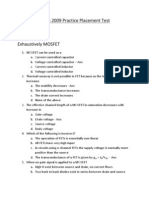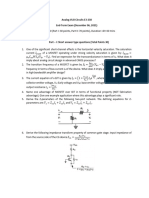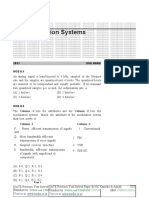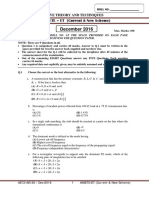SMDP Instructional Enhancement Programme: 13-24 Nov. 2006: Nagendra Krishnapura (Nagendra@iitm - Ac.in) 13 Nov. 2006
SMDP Instructional Enhancement Programme: 13-24 Nov. 2006: Nagendra Krishnapura (Nagendra@iitm - Ac.in) 13 Nov. 2006
Uploaded by
alkjhlkjlkCopyright:
Available Formats
SMDP Instructional Enhancement Programme: 13-24 Nov. 2006: Nagendra Krishnapura (Nagendra@iitm - Ac.in) 13 Nov. 2006
SMDP Instructional Enhancement Programme: 13-24 Nov. 2006: Nagendra Krishnapura (Nagendra@iitm - Ac.in) 13 Nov. 2006
Uploaded by
alkjhlkjlkOriginal Description:
Original Title
Copyright
Available Formats
Share this document
Did you find this document useful?
Is this content inappropriate?
Copyright:
Available Formats
SMDP Instructional Enhancement Programme: 13-24 Nov. 2006: Nagendra Krishnapura (Nagendra@iitm - Ac.in) 13 Nov. 2006
SMDP Instructional Enhancement Programme: 13-24 Nov. 2006: Nagendra Krishnapura (Nagendra@iitm - Ac.in) 13 Nov. 2006
Uploaded by
alkjhlkjlkCopyright:
Available Formats
SMDP Instructional Enhancement Programme: 13-24 Nov.
2006
Nagendra Krishnapura (nagendra@iitm.ac.in)
13 Nov. 2006
1k
1k 1pF
+
-
V
s
+
-
V
out
Figure 1:
1. (a) Compute the transfer function
V
out
(s)/V
in
(s) of the circuit in Fig. 1
analytically.
(b) Simulate the circuit from 10 MHz to
10 GHz and plot a) the magnitude and
phase response, b) Input referred noise
spectral density, c) output noise spectral
density.
(c) Find the 3dB bandwidth of the circuit.
(d) Run a transient simulation with a 0.5 V
peak sinusoid at the 3 dB bandwidth and
plot the output. Are the magnitude and
phase consistent with what was computed
in (b)?
50fF 50fF 25 25
37.5
port1 port2
Figure 2:
2. Simulate and plot the s-parameters of the circuit
in Fig. 2 in a 50 system.
-0.9V
+0.9V
V
p
sin(2f
in
t)
2k 2k
1mA
W/L W/L
W/L=10(2.5/0.18)
f
in
=127MHz
Figure 3:
3. (a) Plot the magnitude and phase response of
the circuit in Fig. 3.
(b) Plot the input referred and output noise
spectral densities
(c) Simulate the circuit with a 127 MHz si-
nusoid with peak values of 50 mV and
200 mV. Take the DFT of the output with
1024 points and determine the 2
nd
and 3
rd
harmonic distortion in each case.
L
1
L
2
C
+
-
v
x
g
m
v
x
+
-
V
in
Z
in
L
1
= 12nH
L
2
= 4nH
C = 0.25pF
g
m
= 3.125mS
I
out
Figure 4:
4. (a) Compute the input impedance Z
in
(s) of
the circuit in Fig. 1 analytically. Com-
1
2
pute the frequency f
0
at which the input
impedance is real and the input impedance
at f
0
. Calculate I
out
(s)/V
in
(s).
(b) From ac simulations determine the fre-
quency at which the input impedance is
real, and the input impedance at that fre-
quency. Compare the answers with analyt-
ical calculations. Simulate the frequency
response I
out
(s)/V
in
(s).
You might also like
- Answer:: Question 1 (2 Points)Document3 pagesAnswer:: Question 1 (2 Points)oke dmm50% (2)
- IES CONV Electronic Comm. 1998Document9 pagesIES CONV Electronic Comm. 1998gateandiesNo ratings yet
- Gate Mock Test1Document17 pagesGate Mock Test1Gopinathan SudheerNo ratings yet
- Basic Electronics (ECE 1051)Document2 pagesBasic Electronics (ECE 1051)aryansorout1612No ratings yet
- Analog Electronics (0500625) SET 1Document8 pagesAnalog Electronics (0500625) SET 1Avinash PandeyNo ratings yet
- IES CONV Electronic Comm. 2000Document11 pagesIES CONV Electronic Comm. 2000gateandiesNo ratings yet
- RCPP QuestionSet 1Document23 pagesRCPP QuestionSet 1Siddhanth SharmaNo ratings yet
- Lab Report 2Document17 pagesLab Report 2Nguyễn ThắngNo ratings yet
- DRDO Question Paper ECE 2008Document12 pagesDRDO Question Paper ECE 2008nagaNo ratings yet
- An Alumnus of Iisc, Bangalore Initiative: Analog CircuitsDocument16 pagesAn Alumnus of Iisc, Bangalore Initiative: Analog CircuitsBakshi AmitNo ratings yet
- Q. 1 - Q. 25 Carry One Mark Each.: X A X AADocument14 pagesQ. 1 - Q. 25 Carry One Mark Each.: X A X AAGauravArjariaNo ratings yet
- RF Lab Report 1Document19 pagesRF Lab Report 1Nguyễn ThắngNo ratings yet
- EC6401Document2 pagesEC6401jdn6qkm3l1No ratings yet
- (WWW - Entrance-Exam - Net) - GATE ECE Solved Paper - 2003Document20 pages(WWW - Entrance-Exam - Net) - GATE ECE Solved Paper - 2003Nandha KumarNo ratings yet
- 2006Document11 pages2006simplymeashishNo ratings yet
- ANE - Tut 1-Merged-MergedDocument10 pagesANE - Tut 1-Merged-MergedadityaNo ratings yet
- 13A04101 Network Analysis JNTUA Regular Examinations 2014Document2 pages13A04101 Network Analysis JNTUA Regular Examinations 2014purushg62No ratings yet
- Mock ExamDocument20 pagesMock ExamkandulanageshNo ratings yet
- 2020 FinalDocument3 pages2020 FinalBen ChouNo ratings yet
- Jntu Hyd 2 2ece Eca Set 2Document18 pagesJntu Hyd 2 2ece Eca Set 2Travis BennettNo ratings yet
- EC3058D-VLSI Circuits and Systems Winter Semester-2020-21Document2 pagesEC3058D-VLSI Circuits and Systems Winter Semester-2020-21Gamer AnonymousNo ratings yet
- 5 D J 2017 - S 1C E VII 17:00/18:15H - T: Departamento de Engenharia Electrotécnica 1 E E III / R 3 T 17:00/20:00H - EDocument2 pages5 D J 2017 - S 1C E VII 17:00/18:15H - T: Departamento de Engenharia Electrotécnica 1 E E III / R 3 T 17:00/20:00H - EHelder CruzNo ratings yet
- Jntuk 2 1 Eca II Nov 2017 Q.PDocument8 pagesJntuk 2 1 Eca II Nov 2017 Q.PSd KhadarNo ratings yet
- Ee 2009 Gate PaperDocument16 pagesEe 2009 Gate Papermass1984No ratings yet
- Ec 2007Document11 pagesEc 2007mallanna4blogsNo ratings yet
- Third Semester B.Tech. (Engineering) Degree Examination, December 2009Document3 pagesThird Semester B.Tech. (Engineering) Degree Examination, December 2009akumar_277No ratings yet
- II B.Tech II Semester, Regular Examinations, April - 2012 Electrical Circuit Analysis - IiDocument8 pagesII B.Tech II Semester, Regular Examinations, April - 2012 Electrical Circuit Analysis - IiViswa ChaitanyaNo ratings yet
- Analog Integrated Circuit Design: Nagendra KrishnapuraDocument26 pagesAnalog Integrated Circuit Design: Nagendra KrishnapuraAnkit Bhoomia0% (1)
- Btech 2009 Practice Placement TestDocument17 pagesBtech 2009 Practice Placement TestDhruv BhatnagarNo ratings yet
- Kbhilai School of Engineering, DurgDocument4 pagesKbhilai School of Engineering, DurgBhupatimtechNo ratings yet
- Practice: Figure 1: An Analog MultiplierDocument2 pagesPractice: Figure 1: An Analog MultiplierHùng NghiêmNo ratings yet
- Electronic and Communication 2010::: Firstranker'S ChoiceDocument14 pagesElectronic and Communication 2010::: Firstranker'S ChoiceUtkarsh JainNo ratings yet
- Gate - in 2010Document17 pagesGate - in 2010prabhjot singh1No ratings yet
- EC Mock Test-3Document20 pagesEC Mock Test-3Arone AsadasNo ratings yet
- 1DRDO Aptitude Paper Sept 2008Document13 pages1DRDO Aptitude Paper Sept 2008ML NarasimhamNo ratings yet
- BSNL GE-JTO Recruitment Examination: Power Factor CorrectionDocument11 pagesBSNL GE-JTO Recruitment Examination: Power Factor CorrectionChamps LalaniNo ratings yet
- Analog CommunicationsDocument4 pagesAnalog CommunicationsJagadeesh KumarNo ratings yet
- End Term E3 238Document6 pagesEnd Term E3 238bommena vishwa tejaNo ratings yet
- Jntu Hyd 2 2ece PDC Set 2Document18 pagesJntu Hyd 2 2ece PDC Set 2Krishna RamaNo ratings yet
- Sample Questions For Entrance Test: Fig. 1. Magnitude PlotDocument4 pagesSample Questions For Entrance Test: Fig. 1. Magnitude PlotPadmanabhan.89No ratings yet
- A Exit Exam Model From EPCE - EeennoooDocument19 pagesA Exit Exam Model From EPCE - Eeennoooousmi2741No ratings yet
- EEC501Document2 pagesEEC501raviNo ratings yet
- Obj 1997paper 2Document15 pagesObj 1997paper 2Uday KakkarNo ratings yet
- Full4 PDFDocument20 pagesFull4 PDFthumatimadhusudhanNo ratings yet
- Mock Gate EEEDocument13 pagesMock Gate EEEnaga01013ee022No ratings yet
- Communication Systems With SolutionsDocument90 pagesCommunication Systems With SolutionsTalha SadiqNo ratings yet
- Electrical Circuit Analysis - II 2 Question PapersDocument8 pagesElectrical Circuit Analysis - II 2 Question Paperssrinu247100% (1)
- ECA-II Question PapersDocument86 pagesECA-II Question Paperssatyakar_vvkNo ratings yet
- Exp 3Document5 pagesExp 3MariaNo ratings yet
- Homework #1: DD OutDocument1 pageHomework #1: DD OutSiddharthJainNo ratings yet
- Communication Systems With SolutionsDocument109 pagesCommunication Systems With SolutionsChindam Hari Prasad50% (2)
- Electronics Past Test Questions and MemoDocument22 pagesElectronics Past Test Questions and MemoPrevin BogopaNo ratings yet
- Analog ElectronicsDocument77 pagesAnalog ElectronicsramyaranganayakiNo ratings yet
- December 2016: AMIETE - ET (Current & New Scheme)Document3 pagesDecember 2016: AMIETE - ET (Current & New Scheme)mraavulaNo ratings yet
- Ece 1071 - Ece-1071 - Basic ElectronicsDocument2 pagesEce 1071 - Ece-1071 - Basic ElectronicsChalla SaiNo ratings yet
- Question Paper: A Answer All The QuestionsDocument3 pagesQuestion Paper: A Answer All The QuestionsHarshita GauravNo ratings yet
- Gate - in 2007Document30 pagesGate - in 2007prabhjot singh1No ratings yet
- Fundamentals of Electronics 2: Continuous-time Signals and SystemsFrom EverandFundamentals of Electronics 2: Continuous-time Signals and SystemsNo ratings yet
- EE5390 Analog Integrated Circuit Design Assignment 2: β. Fig. 2 (b) shows a nonlinearity f preceded byDocument1 pageEE5390 Analog Integrated Circuit Design Assignment 2: β. Fig. 2 (b) shows a nonlinearity f preceded byalkjhlkjlkNo ratings yet
- Special Manpower Development Program in VLSI Design IEP: Radio Frequency Integrated Circuit Design Shanthi@ee - Iitm.ac - inDocument2 pagesSpecial Manpower Development Program in VLSI Design IEP: Radio Frequency Integrated Circuit Design Shanthi@ee - Iitm.ac - inalkjhlkjlkNo ratings yet
- SMDP Instructional Enhancement Programme: 13-24 Nov. 2006: Nagendra Krishnapura (Nagendra@iitm - Ac.in) 18 Nov. 2006Document1 pageSMDP Instructional Enhancement Programme: 13-24 Nov. 2006: Nagendra Krishnapura (Nagendra@iitm - Ac.in) 18 Nov. 2006alkjhlkjlkNo ratings yet
- HW 03Document1 pageHW 03alkjhlkjlkNo ratings yet
- SMDP Instructional Enhancement Programme: 13-24 Nov. 2006: Nagendra Krishnapura (Nagendra@iitm - Ac.in) 15 Nov. 2006Document1 pageSMDP Instructional Enhancement Programme: 13-24 Nov. 2006: Nagendra Krishnapura (Nagendra@iitm - Ac.in) 15 Nov. 2006alkjhlkjlkNo ratings yet
- Advanced Electrical Networks: Problem Set 5Document1 pageAdvanced Electrical Networks: Problem Set 5alkjhlkjlkNo ratings yet

































































